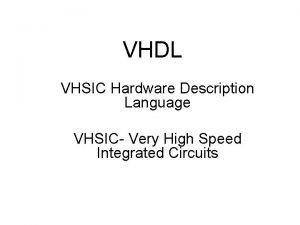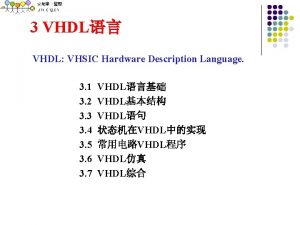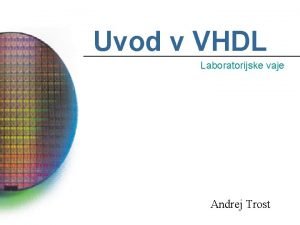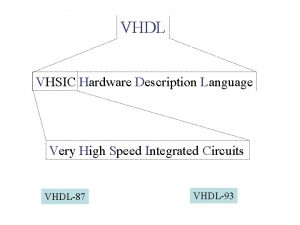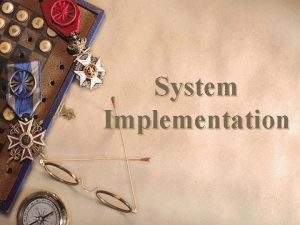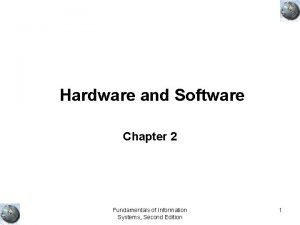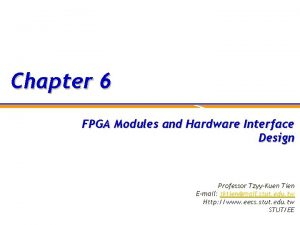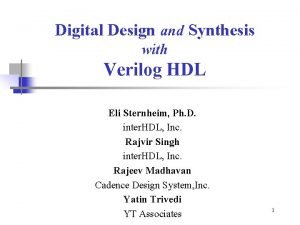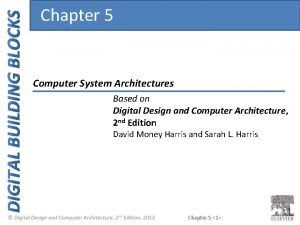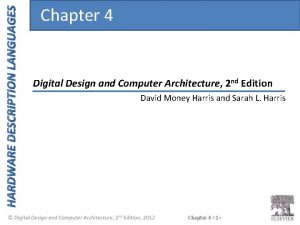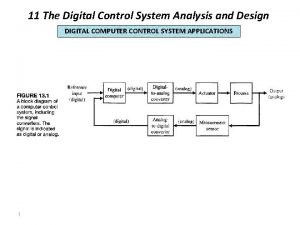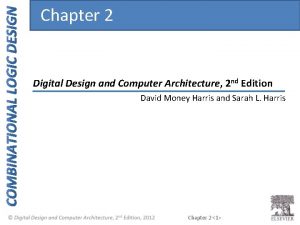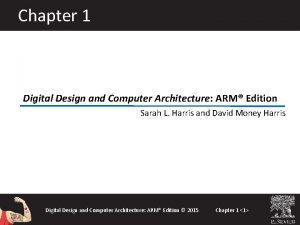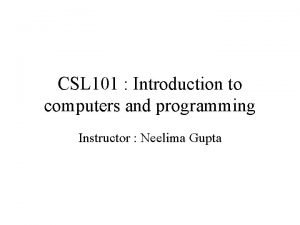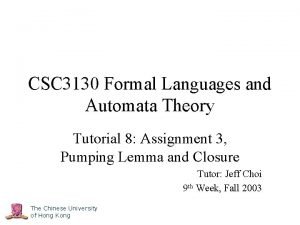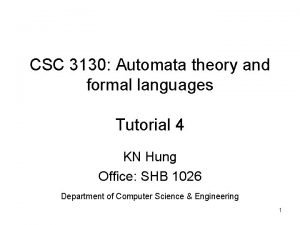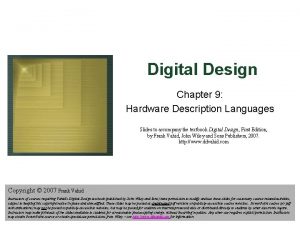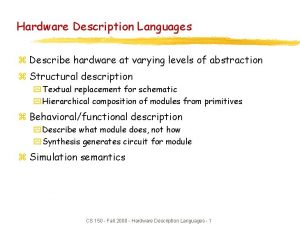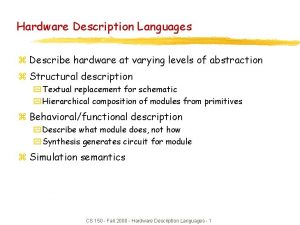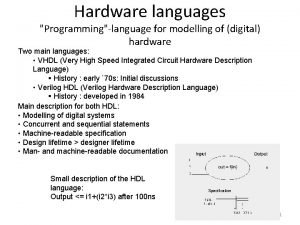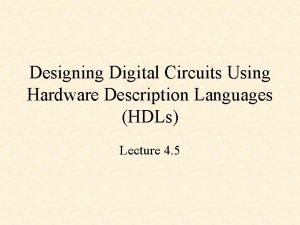Chapter 4 Hardware Description Languages Digital Design and










![Bitwise Operators module gates(input [3: 0] a, b, output [3: 0] y 1, y Bitwise Operators module gates(input [3: 0] a, b, output [3: 0] y 1, y](https://slidetodoc.com/presentation_image/42f86dbc788e7f7e2f7f550d080614cb/image-11.jpg)
![Reduction Operators module and 8(input [7: 0] a, output y); assign y = &a; Reduction Operators module and 8(input [7: 0] a, output y); assign y = &a;](https://slidetodoc.com/presentation_image/42f86dbc788e7f7e2f7f550d080614cb/image-12.jpg)
![Conditional Assignment module mux 2(input [3: 0] d 0, d 1, input s, output Conditional Assignment module mux 2(input [3: 0] d 0, d 1, input s, output](https://slidetodoc.com/presentation_image/42f86dbc788e7f7e2f7f550d080614cb/image-13.jpg)



![Bit Manipulations: Example 1 assign y = {a[2: 1], {3{b[0]}}, a[0], 6’b 100_010}; // Bit Manipulations: Example 1 assign y = {a[2: 1], {3{b[0]}}, a[0], 6’b 100_010}; //](https://slidetodoc.com/presentation_image/42f86dbc788e7f7e2f7f550d080614cb/image-17.jpg)
![Bit Manipulations: Example 2 Verilog: module mux 2_8(input [7: 0] d 0, d 1, Bit Manipulations: Example 2 Verilog: module mux 2_8(input [7: 0] d 0, d 1,](https://slidetodoc.com/presentation_image/42f86dbc788e7f7e2f7f550d080614cb/image-18.jpg)
![Z: Floating Output Verilog: module tristate(input [3: 0] a, input en, output [3: 0] Z: Floating Output Verilog: module tristate(input [3: 0] a, input en, output [3: 0]](https://slidetodoc.com/presentation_image/42f86dbc788e7f7e2f7f550d080614cb/image-19.jpg)




![D Flip-Flop module flop(input clk, input [3: 0] d, output reg [3: 0] q); D Flip-Flop module flop(input clk, input [3: 0] d, output reg [3: 0] q);](https://slidetodoc.com/presentation_image/42f86dbc788e7f7e2f7f550d080614cb/image-24.jpg)
![Resettable D Flip-Flop module flopr(input clk, input reset, input [3: 0] d, output reg Resettable D Flip-Flop module flopr(input clk, input reset, input [3: 0] d, output reg](https://slidetodoc.com/presentation_image/42f86dbc788e7f7e2f7f550d080614cb/image-25.jpg)
![Resettable D Flip-Flop module flopr(input clk, input reset, input [3: 0] d, output reg Resettable D Flip-Flop module flopr(input clk, input reset, input [3: 0] d, output reg](https://slidetodoc.com/presentation_image/42f86dbc788e7f7e2f7f550d080614cb/image-26.jpg)
![D Flip-Flop with Enable module flopren(input clk, input reset, input en, input [3: 0] D Flip-Flop with Enable module flopren(input clk, input reset, input en, input [3: 0]](https://slidetodoc.com/presentation_image/42f86dbc788e7f7e2f7f550d080614cb/image-27.jpg)
![Latch module latch(input clk, input [3: 0] d, output reg [3: 0] q); always Latch module latch(input clk, input [3: 0] d, output reg [3: 0] q); always](https://slidetodoc.com/presentation_image/42f86dbc788e7f7e2f7f550d080614cb/image-28.jpg)


![Combinational Logic using case module sevenseg(input [3: 0] data, output reg [6: 0] segments); Combinational Logic using case module sevenseg(input [3: 0] data, output reg [6: 0] segments);](https://slidetodoc.com/presentation_image/42f86dbc788e7f7e2f7f550d080614cb/image-31.jpg)

![Combinational Logic using casez module priority_casez(input [3: 0] a, output reg [3: 0] y); Combinational Logic using casez module priority_casez(input [3: 0] a, output reg [3: 0] y);](https://slidetodoc.com/presentation_image/42f86dbc788e7f7e2f7f550d080614cb/image-33.jpg)



















- Slides: 52

Chapter 4 : : Hardware Description Languages Digital Design and Computer Architecture David Money Harris and Sarah L. Harris Copyright © 2007 Elsevier 1

Chapter 4 : : Topics • • Introduction Combinational Logic Structural Modeling Sequential Logic More Combinational Logic Finite State Machines Parameterized Modules Testbenches Copyright © 2007 Elsevier 2

Introduction • Hardware description language (HDL): allows designer to specify logic function only. Then a computer-aided design (CAD) tool produces or synthesizes the optimized gates. • Most commercial designs built using HDLs • Two leading HDLs: – Verilog • developed in 1984 by Gateway Design Automation • became an IEEE standard (1364) in 1995 – VHDL • Developed in 1981 by the Department of Defense • Became an IEEE standard (1076) in 1987 Copyright © 2007 Elsevier 3

HDL to Gates • Simulation – Input values are applied to the circuit – Outputs checked for correctness – Millions of dollars saved by debugging in simulation instead of hardware • Synthesis – Transforms HDL code into a netlist describing the hardware (i. e. , a list of gates and the wires connecting them) IMPORTANT: When describing circuits using an HDL, it’s critical to think of the hardware the code should produce. Copyright © 2007 Elsevier 4

Verilog Modules Two types of Modules: – Behavioral: describe what a module does – Structural: describe how a module is built from simpler modules Copyright © 2007 Elsevier 5

Behavioral Verilog Example Verilog: module example(input a, b, c, output y); assign y = ~a & ~b & ~c | a & ~b & endmodule Copyright © 2007 Elsevier c; 6

Behavioral Verilog Simulation Verilog: module example(input a, b, c, output y); assign y = ~a & ~b & ~c | a & ~b & endmodule Copyright © 2007 Elsevier c; 7

Behavioral Verilog Synthesis Verilog: module example(input a, b, c, output y); assign y = ~a & ~b & ~c | a & ~b & endmodule c; Synthesis: Copyright © 2007 Elsevier 8

Verilog Syntax • Case sensitive – Example: reset and Reset are not the same signal. • No names that start with numbers – Example: 2 mux is an invalid name. • Whitespace ignored • Comments: – // single line comment – /* multiline comment */ Copyright © 2007 Elsevier 9

Structural Modeling - Hierarchy module and 3(input a, b, c, output y); assign y = a & b & c; endmodule inv(input a, output y); assign y = ~a; endmodule nand 3(input a, b, c output y); wire n 1; // internal signal and 3 andgate(a, b, c, n 1); // instance of and 3 inverter(n 1, y); // instance of inverter endmodule Copyright © 2007 Elsevier 10
![Bitwise Operators module gatesinput 3 0 a b output 3 0 y 1 y Bitwise Operators module gates(input [3: 0] a, b, output [3: 0] y 1, y](https://slidetodoc.com/presentation_image/42f86dbc788e7f7e2f7f550d080614cb/image-11.jpg)
Bitwise Operators module gates(input [3: 0] a, b, output [3: 0] y 1, y 2, y 3, y 4, y 5); /* Five different two-input logic gates acting on 4 bit busses */ assign y 1 = a & b; // AND assign y 2 = a | b; // OR assign y 3 = a ^ b; // XOR assign y 4 = ~(a & b); // NAND assign y 5 = ~(a | b); // NOR endmodule // /*…*/ Copyright © 2007 Elsevier single line comment multiline comment 11
![Reduction Operators module and 8input 7 0 a output y assign y a Reduction Operators module and 8(input [7: 0] a, output y); assign y = &a;](https://slidetodoc.com/presentation_image/42f86dbc788e7f7e2f7f550d080614cb/image-12.jpg)
Reduction Operators module and 8(input [7: 0] a, output y); assign y = &a; // &a is much easier to write than // assign y = a[7] & a[6] & a[5] & a[4] & // a[3] & a[2] & a[1] & a[0]; endmodule Copyright © 2007 Elsevier 12
![Conditional Assignment module mux 2input 3 0 d 0 d 1 input s output Conditional Assignment module mux 2(input [3: 0] d 0, d 1, input s, output](https://slidetodoc.com/presentation_image/42f86dbc788e7f7e2f7f550d080614cb/image-13.jpg)
Conditional Assignment module mux 2(input [3: 0] d 0, d 1, input s, output [3: 0] y); assign y = s ? d 1 : d 0; endmodule ? : Copyright © 2007 Elsevier is also called a ternary operator because it operates on 3 inputs: s, d 1, and d 0. 13

Internal Variables module fulladder(input a, b, cin, output s, cout); wire p, g; // internal nodes assign p = a ^ b; assign g = a & b; assign s = p ^ cin; assign cout = g | (p & cin); endmodule Copyright © 2007 Elsevier 14

Precedence Defines the order of operations Highest ~ NOT *, /, % mult, div, mod +, - add, sub <<, >> shift <<<, >>> arithmetic shift <, <=, >, >= comparison Lowest Copyright © 2007 Elsevier ==, != equal, not equal &, ~& AND, NAND ^, ~^ XOR, XNOR |, ~| OR, XOR ? : ternary operator 15

Numbers Format: N'Bvalue N = number of bits, B = base N'B is optional but recommended (default is decimal) Number # Bits Base Decimal Equivalent Stored 3’b 101 3 binary 5 101 ‘b 11 unsized binary 3 00… 0011 8’b 11 8 binary 3 00000011 8’b 1010_1011 8 binary 171 10101011 3’d 6 3 decimal 6 110 6’o 42 6 octal 34 100010 8’h. AB 8 hexadecimal 171 10101011 42 Unsized decimal 42 00… 0101010 Copyright © 2007 Elsevier 16
![Bit Manipulations Example 1 assign y a2 1 3b0 a0 6b 100010 Bit Manipulations: Example 1 assign y = {a[2: 1], {3{b[0]}}, a[0], 6’b 100_010}; //](https://slidetodoc.com/presentation_image/42f86dbc788e7f7e2f7f550d080614cb/image-17.jpg)
Bit Manipulations: Example 1 assign y = {a[2: 1], {3{b[0]}}, a[0], 6’b 100_010}; // if y is a 12 -bit signal, the above statement produces: y = a[2] a[1] b[0] a[0] 1 0 0 0 1 0 // underscores (_) are used formatting only to make it easier to read. Verilog ignores them. Copyright © 2007 Elsevier 17
![Bit Manipulations Example 2 Verilog module mux 28input 7 0 d 0 d 1 Bit Manipulations: Example 2 Verilog: module mux 2_8(input [7: 0] d 0, d 1,](https://slidetodoc.com/presentation_image/42f86dbc788e7f7e2f7f550d080614cb/image-18.jpg)
Bit Manipulations: Example 2 Verilog: module mux 2_8(input [7: 0] d 0, d 1, input s, output [7: 0] y); mux 2 lsbmux(d 0[3: 0], d 1[3: 0], s, y[3: 0]); mux 2 msbmux(d 0[7: 4], d 1[7: 4], s, y[7: 4]); endmodule Synthesis: Copyright © 2007 Elsevier 18
![Z Floating Output Verilog module tristateinput 3 0 a input en output 3 0 Z: Floating Output Verilog: module tristate(input [3: 0] a, input en, output [3: 0]](https://slidetodoc.com/presentation_image/42f86dbc788e7f7e2f7f550d080614cb/image-19.jpg)
Z: Floating Output Verilog: module tristate(input [3: 0] a, input en, output [3: 0] y); assign y = en ? a : 4'bz; endmodule Synthesis: Copyright © 2007 Elsevier 19

Delays module example(input a, b, c, output y); wire ab, bb, cb, n 1, n 2, n 3; assign #1 {ab, bb, cb} = ~{a, b, c}; assign #2 n 1 = ab & bb & cb; assign #2 n 2 = a & bb & cb; assign #2 n 3 = a & bb & c; assign #4 y = n 1 | n 2 | n 3; endmodule Copyright © 2007 Elsevier 20

Delays module example(input a, b, c, output y); wire ab, bb, cb, n 1, n 2, n 3; assign #1 {ab, bb, cb} = ~{a, b, c}; assign #2 n 1 = ab & bb & cb; assign #2 n 2 = a & bb & cb; assign #2 n 3 = a & bb & c; assign #4 y = n 1 | n 2 | n 3; endmodule Copyright © 2007 Elsevier 21

Sequential Logic • Verilog uses certain idioms to describe latches, flip-flops and FSMs • Other coding styles may simulate correctly but produce incorrect hardware Copyright © 2007 Elsevier 22

Always Statement General Structure: always @ (sensitivity list) statement; Whenever the event in the sensitivity list occurs, the statement is executed Copyright © 2007 Elsevier 23
![D FlipFlop module flopinput clk input 3 0 d output reg 3 0 q D Flip-Flop module flop(input clk, input [3: 0] d, output reg [3: 0] q);](https://slidetodoc.com/presentation_image/42f86dbc788e7f7e2f7f550d080614cb/image-24.jpg)
D Flip-Flop module flop(input clk, input [3: 0] d, output reg [3: 0] q); always @ (posedge clk) q <= d; // pronounced “q gets d” endmodule Any signal assigned in an always statement must be declared reg. In this case q is declared as reg Beware: A variable declared reg is not necessarily a registered output. We will show examples of this later. Copyright © 2007 Elsevier 24
![Resettable D FlipFlop module floprinput clk input reset input 3 0 d output reg Resettable D Flip-Flop module flopr(input clk, input reset, input [3: 0] d, output reg](https://slidetodoc.com/presentation_image/42f86dbc788e7f7e2f7f550d080614cb/image-25.jpg)
Resettable D Flip-Flop module flopr(input clk, input reset, input [3: 0] d, output reg [3: 0] q); // synchronous reset always @ (posedge clk) if (reset) q <= 4'b 0; else q <= d; endmodule Copyright © 2007 Elsevier 25
![Resettable D FlipFlop module floprinput clk input reset input 3 0 d output reg Resettable D Flip-Flop module flopr(input clk, input reset, input [3: 0] d, output reg](https://slidetodoc.com/presentation_image/42f86dbc788e7f7e2f7f550d080614cb/image-26.jpg)
Resettable D Flip-Flop module flopr(input clk, input reset, input [3: 0] d, output reg [3: 0] q); // asynchronous reset always @ (posedge clk, posedge reset) if (reset) q <= 4'b 0; else q <= d; endmodule Copyright © 2007 Elsevier 26
![D FlipFlop with Enable module flopreninput clk input reset input en input 3 0 D Flip-Flop with Enable module flopren(input clk, input reset, input en, input [3: 0]](https://slidetodoc.com/presentation_image/42f86dbc788e7f7e2f7f550d080614cb/image-27.jpg)
D Flip-Flop with Enable module flopren(input clk, input reset, input en, input [3: 0] d, output reg [3: 0] q); // asynchronous reset and enable always @ (posedge clk, posedge reset) if (reset) q <= 4'b 0; else if (en) q <= d; endmodule Copyright © 2007 Elsevier 27
![Latch module latchinput clk input 3 0 d output reg 3 0 q always Latch module latch(input clk, input [3: 0] d, output reg [3: 0] q); always](https://slidetodoc.com/presentation_image/42f86dbc788e7f7e2f7f550d080614cb/image-28.jpg)
Latch module latch(input clk, input [3: 0] d, output reg [3: 0] q); always @ (clk, d) if (clk) q <= d; endmodule Warning: We won’t use latches in this course, but you might write code that inadvertently implies a latch. So if your synthesized hardware has latches in it, this indicates an error. Copyright © 2007 Elsevier 28

Other Behavioral Statements • Statements that must be inside always statements: – if / else – case, casez • Reminder: Variables assigned in an always statement must be declared as reg (even if they’re not actually registered!) Copyright © 2007 Elsevier 29

Combinational Logic using always // combinational logic using an always statement module gates(input [3: 0] a, b, output reg [3: 0] y 1, y 2, y 3, y 4, y 5); always @(*) // need begin/end because there is begin // more than one statement in always y 1 = a & b; // AND y 2 = a | b; // OR y 3 = a ^ b; // XOR y 4 = ~(a & b); // NAND y 5 = ~(a | b); // NOR endmodule This hardware could be described with assign statements using fewer lines of code, so it’s better to use assign statements in this case. Copyright © 2007 Elsevier 30
![Combinational Logic using case module sevenseginput 3 0 data output reg 6 0 segments Combinational Logic using case module sevenseg(input [3: 0] data, output reg [6: 0] segments);](https://slidetodoc.com/presentation_image/42f86dbc788e7f7e2f7f550d080614cb/image-31.jpg)
Combinational Logic using case module sevenseg(input [3: 0] data, output reg [6: 0] segments); always @(*) case (data) // abc_defg 0: segments = 7'b 111_1110; 1: segments = 7'b 011_0000; 2: segments = 7'b 110_1101; 3: segments = 7'b 111_1001; 4: segments = 7'b 011_0011; 5: segments = 7'b 101_1011; 6: segments = 7'b 101_1111; 7: segments = 7'b 111_0000; 8: segments = 7'b 111_1111; 9: segments = 7'b 111_1011; default: segments = 7'b 000_0000; // required endcase endmodule Copyright © 2007 Elsevier 31

Combinational Logic using case • In order for a case statement to imply combinational logic, all possible input combinations must be described by the HDL. • Remember to use a default statement when necessary. Copyright © 2007 Elsevier 32
![Combinational Logic using casez module prioritycasezinput 3 0 a output reg 3 0 y Combinational Logic using casez module priority_casez(input [3: 0] a, output reg [3: 0] y);](https://slidetodoc.com/presentation_image/42f86dbc788e7f7e2f7f550d080614cb/image-33.jpg)
Combinational Logic using casez module priority_casez(input [3: 0] a, output reg [3: 0] y); always @(*) casez(a) 4'b 1? ? ? : 4'b 01? ? : 4'b 001? : 4'b 0001: default: endcase y y y = = = 4'b 1000; 4'b 0100; 4'b 0010; 4'b 0001; 4'b 0000; // ? = don’t care endmodule Copyright © 2007 Elsevier 33

Blocking vs. Nonblocking Assignments • <= is a “nonblocking assignment” – Occurs simultaneously with others • = is a “blocking assignment” – Occurs in the order it appears in the file // Good synchronizer using // nonblocking assignments module syncgood(input clk, input d, output reg q); reg n 1; always @(posedge clk) begin n 1 <= d; // nonblocking q <= n 1; // nonblocking endmodule Copyright © 2007 Elsevier // Bad synchronizer using // blocking assignments module syncbad(input clk, input d, output reg q); reg n 1; always @(posedge clk) begin n 1 = d; // blocking q = n 1; // blocking endmodule 34

Rules for Signal Assignment • Use always @(posedge clk) and nonblocking assignments (<=) to model synchronous sequential logic always @ (posedge clk) q <= d; // nonblocking • Use continuous assignments (assign …)to model simple combinational logic. assign y = a & b; • Use always @ (*) and blocking assignments (=) to model more complicated combinational logic where the always statement is helpful. • Do not make assignments to the same signal in more than one always statement or continuous assignment statement. Copyright © 2007 Elsevier 35

Finite State Machines (FSMs) • Three blocks: – next state logic – state register – output logic Copyright © 2007 Elsevier 36

FSM Example: Divide by 3 The double circle indicates the reset state Copyright © 2007 Elsevier 37

FSM in Verilog module divideby 3 FSM (input clk, input reset, output q); reg [1: 0] state, nextstate; parameter S 0 = 2'b 00; parameter S 1 = 2'b 01; parameter S 2 = 2'b 10; Copyright © 2007 Elsevier // state register always @ (posedge clk, posedge reset) if (reset) state <= S 0; else state <= nextstate; // next state logic always @ (*) case (state) S 0: nextstate = S 1; S 1: nextstate = S 2; S 2: nextstate = S 0; default: nextstate = S 0; endcase // output logic assign q = (state == S 0); endmodule 38

Parameterized Modules 2: 1 mux: module mux 2 #(parameter width = 8) // name and default value (input [width-1: 0] d 0, d 1, input s, output [width-1: 0] y); assign y = s ? d 1 : d 0; endmodule Instance with 8 -bit bus width (uses default): mux 2 mux 1(d 0, d 1, s, out); Instance with 12 -bit bus width: mux 2 #(12) lowmux(d 0, d 1, s, out); Copyright © 2007 Elsevier 39

Testbenches • HDL code written to test another HDL module, the device under test (dut), also called the unit under test (uut) • Not synthesizeable • Types of testbenches: – Simple testbench – Self-checking testbench with testvectors Copyright © 2007 Elsevier 40

Example Write Verilog code to implement the following function in hardware: y = bc + ab Name the module sillyfunction Copyright © 2007 Elsevier 41

Example Write Verilog code to implement the following function in hardware: y = bc + ab Name the module sillyfunction Verilog module sillyfunction(input a, b, c, output y); assign y = ~b & ~c | a & ~b; endmodule Copyright © 2007 Elsevier 42

Simple Testbench Copyright © 2007 Elsevier module testbench 1(); reg a, b, c; wire y; // instantiate device under test sillyfunction dut(a, b, c, y); // apply inputs one at a time initial begin a = 0; b = 0; c = 0; #10; c = 1; #10; b = 1; c = 0; #10; c = 1; #10; a = 1; b = 0; c = 0; #10; c = 1; #10; b = 1; c = 0; #10; c = 1; #10; endmodule 43

Self-checking Testbench Copyright © 2007 Elsevier module testbench 2(); reg a, b, c; wire y; // instantiate device under test sillyfunction dut(a, b, c, y); // apply inputs one at a time // checking results initial begin a = 0; b = 0; c = 0; #10; if (y !== 1) $display("000 failed. "); c = 1; #10; if (y !== 0) $display("001 failed. "); b = 1; c = 0; #10; if (y !== 0) $display("010 failed. "); c = 1; #10; if (y !== 0) $display("011 failed. "); a = 1; b = 0; c = 0; #10; if (y !== 1) $display("100 failed. "); c = 1; #10; if (y !== 1) $display("101 failed. "); b = 1; c = 0; #10; if (y !== 0) $display("110 failed. "); c = 1; #10; if (y !== 0) $display("111 failed. "); endmodule 44

Testbench with Testvectors • • Write testvector file: inputs and expected outputs Testbench: 1. 2. 3. 4. Generate clock for assigning inputs, reading outputs Read testvectors file into array Assign inputs, expected outputs Compare outputs to expected outputs and report errors Copyright © 2007 Elsevier 45

Testbench with Testvectors • Testbench clock is used to assign inputs (on the rising edge) and compare outputs with expected outputs (on the falling edge). • The testbench clock may also be used as the clock source for synchronous sequential circuits. Copyright © 2007 Elsevier 46

Testvectors File: example. tv – contains vectors of abc_yexpected 000_1 001_0 010_0 011_0 100_1 101_1 110_0 111_0 Copyright © 2007 Elsevier 47

Testbench: 1. Generate Clock module testbench 3(); reg clk, reset; reg a, b, c, yexpected; wire y; reg [31: 0] vectornum, errors; // bookkeeping variables reg [3: 0] testvectors[10000: 0]; // array of testvectors // instantiate device under test sillyfunction dut(a, b, c, y); // generate clock always // no sensitivity list, so it always executes begin clk = 1; #5; clk = 0; #5; end Copyright © 2007 Elsevier 48

2. Read Testvectors into Array // at start of test, load vectors // and pulse reset initial begin $readmemb("example. tv", testvectors); vectornum = 0; errors = 0; reset = 1; #27; reset = 0; end // Note: $readmemh reads testvector files written in // hexadecimal Copyright © 2007 Elsevier 49

3. Assign Inputs and Expected Outputs // apply test vectors on rising edge of clk always @(posedge clk) begin #1; {a, b, c, yexpected} = testvectors[vectornum]; end Copyright © 2007 Elsevier 50

4. Compare Outputs with Expected Outputs // check results on falling edge of clk always @(negedge clk) if (~reset) begin // skip during reset if (y !== yexpected) begin $display("Error: inputs = %b", {a, b, c}); $display(" outputs = %b (%b expected)", y, yexpected); errors = errors + 1; end // Note: to print in hexadecimal, use %h. For example, // $display(“Error: inputs = %h”, {a, b, c}); Copyright © 2007 Elsevier 51

4. Compare Outputs with Expected Outputs // increment array index and read next testvectornum = vectornum + 1; if (testvectors[vectornum] === 4'bx) begin $display("%d tests completed with %d errors", vectornum, errors); $finish; end endmodule // Note: === and !== can compare values that are // x or z. Copyright © 2007 Elsevier 52
 Hardware description language
Hardware description language Computer external components
Computer external components Vhsic hardware description language
Vhsic hardware description language Hardware description language vs programming language
Hardware description language vs programming language Devider
Devider Hardware description language
Hardware description language The verilog® hardware description language
The verilog® hardware description language Vhsic hardware description language
Vhsic hardware description language Representation and description in digital image processing
Representation and description in digital image processing What is boundary descriptors in digital image processing
What is boundary descriptors in digital image processing Hardware acquisition in system analysis and design
Hardware acquisition in system analysis and design Digital markets and digital goods
Digital markets and digital goods Chapter 2 hardware and software
Chapter 2 hardware and software Ahmet selman bozkır
Ahmet selman bozkır Hardware interface design
Hardware interface design Ceng4480 2021
Ceng4480 2021 Apa yang dimaksud dengan warga digital?
Apa yang dimaksud dengan warga digital? Digital data digital signals
Digital data digital signals Digital data digital signals
Digital data digital signals E-commerce: digital markets, digital goods
E-commerce: digital markets, digital goods Digital data to digital signal encoding
Digital data to digital signal encoding Healthtech mobility
Healthtech mobility E-commerce digital markets digital goods
E-commerce digital markets digital goods System subsystem design description
System subsystem design description Digital systems testing and testable design
Digital systems testing and testable design Digital design and computer architecture arm edition
Digital design and computer architecture arm edition Digital design and computer architecture
Digital design and computer architecture Verilog hdl: a guide to digital design and synthesis pdf
Verilog hdl: a guide to digital design and synthesis pdf Digital design and computer architecture
Digital design and computer architecture Digital design and computer architecture
Digital design and computer architecture Digital control system analysis and design
Digital control system analysis and design Verilog hdl: a guide to digital design and synthesis
Verilog hdl: a guide to digital design and synthesis Digital design and computer architecture
Digital design and computer architecture Digital design and computer architecture: arm edition
Digital design and computer architecture: arm edition Real-time systems and programming languages
Real-time systems and programming languages Cs 421
Cs 421 Languages for life and work
Languages for life and work Types of media languages
Types of media languages Front end and back end of a compiler
Front end and back end of a compiler Proto language
Proto language Defence centre for languages and culture
Defence centre for languages and culture Strongly typed vs weakly typed
Strongly typed vs weakly typed List the primitives that specify a data mining task.
List the primitives that specify a data mining task. Mil media and information languages
Mil media and information languages Csci3130
Csci3130 Formal languages and automata theory tutorial
Formal languages and automata theory tutorial Cyk algorithm
Cyk algorithm Advantages of high level language
Advantages of high level language Nondeterministic means choice of moves for automata *
Nondeterministic means choice of moves for automata * Sound devices examples
Sound devices examples Automata theory tutorial
Automata theory tutorial Csci3130
Csci3130 Real time programming language
Real time programming language


